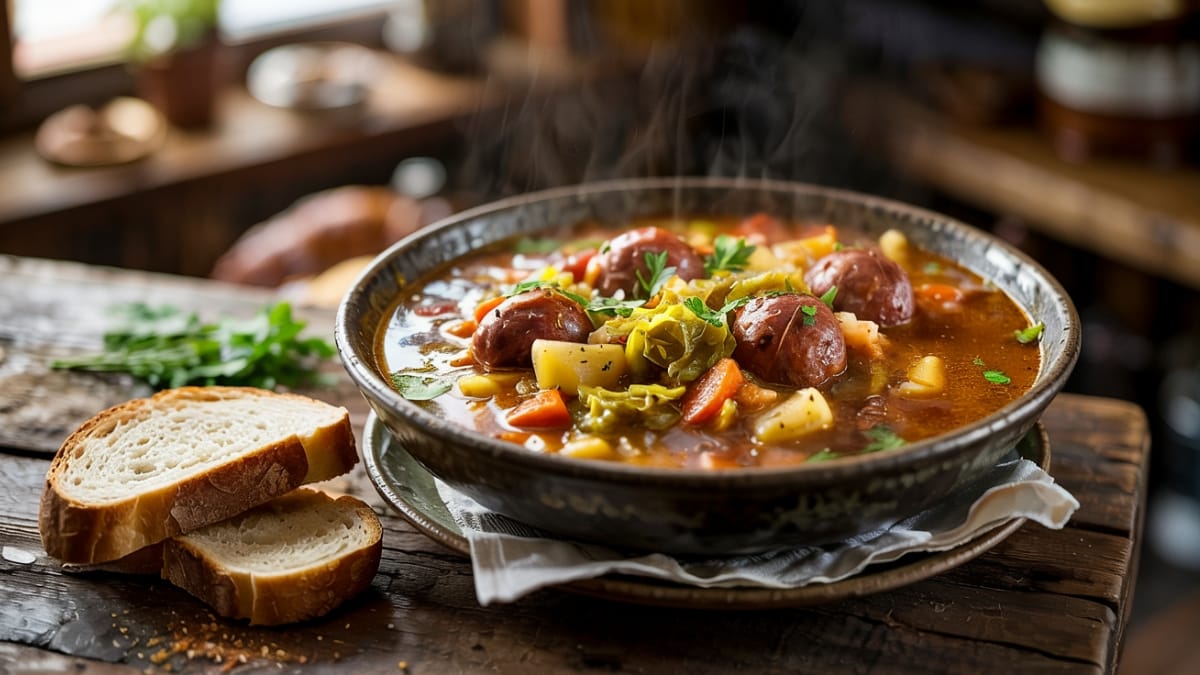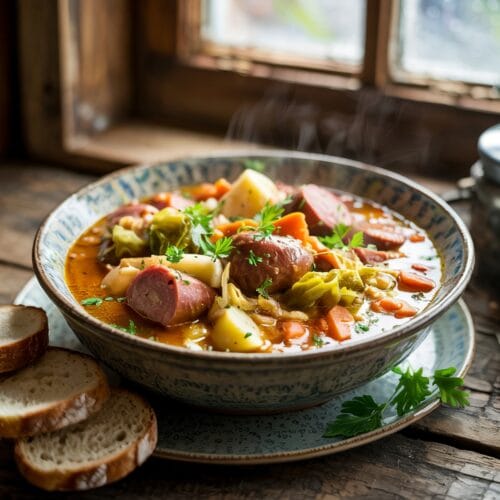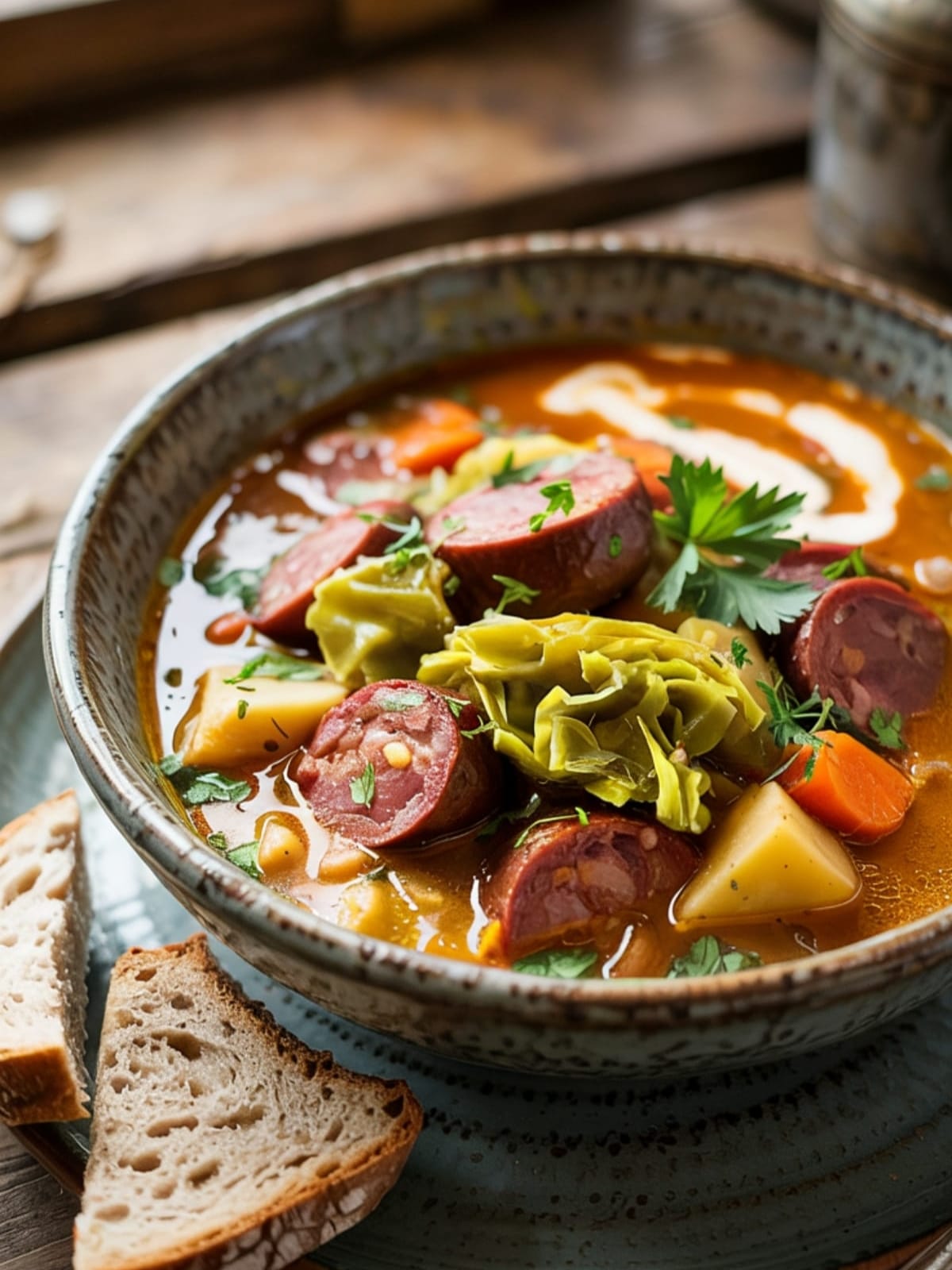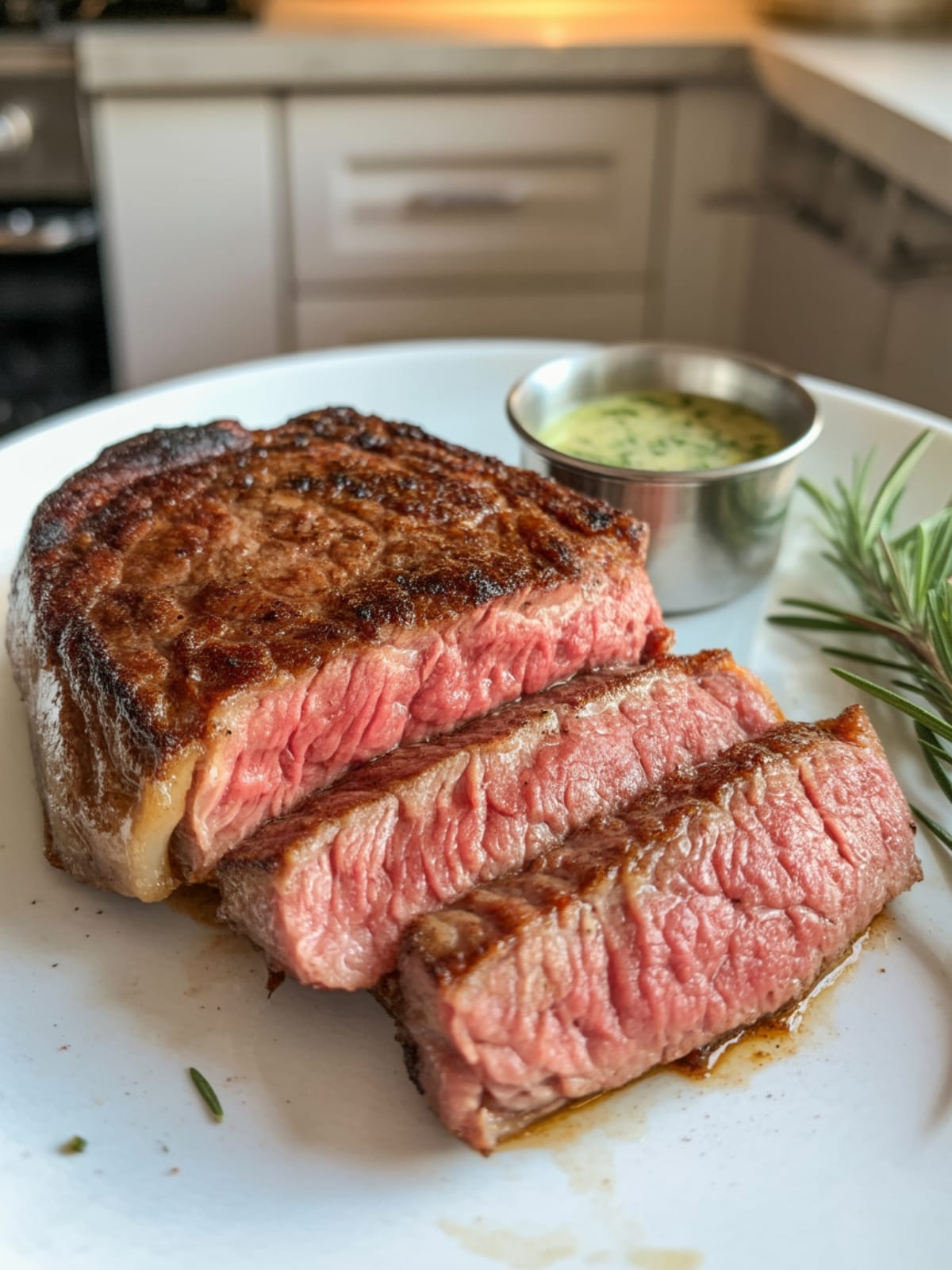Ever wished you could transport yourself to a rowdy Munich beer hall, surrounded by pretzels the size of your head and hearty German fare that sticks to your ribs? While I can’t help you with the airfare, this Oktoberfest stew is the next best thing. It’s like Bavaria in a bowl—minus the oompah band and the guy in suspenders who’s had one too many steins.
Why This Recipe is Awesome

This Oktoberfest stew is what happens when comfort food gets its passport stamped. It combines the soul-warming qualities of a traditional stew with the unmistakable flavors of German cuisine. The result? A dish that makes you want to raise your spoon and shout “Prost!” even if you’re just eating it alone on your couch in sweatpants.
The magic happens when the lager hits the pot. Beer isn’t just for drinking, folks. When added to a stew, it undergoes a magnificent transformation—the alcohol cooks off, leaving behind complex malty notes that infuse everything with depth. It’s like someone turned the flavor dial from a 6 to a solid 10.
Plus, this is one of those recipes that actually improves with time. Make it a day ahead, and you’ve basically given all those ingredients a chance to get better acquainted at the tastiest party in town. The smoked sausage, tender vegetables, and beer-infused broth develop a friendship that only gets stronger overnight.

Oktoberfest Stew with Lager and Sausage
Ingredients
- 2 tablespoons vegetable oil
- 1.5 pounds smoked sausage kielbasa or German-style bratwurst, sliced into rounds
- 2 medium onions chopped
- 2 large carrots peeled and diced
- 2 celery stalks diced
- 1 medium green cabbage cored and roughly chopped (about 6-8 cups)
- 3 cloves garlic minced
- 2 bay leaves
- 1 teaspoon caraway seeds
- 1 teaspoon dried thyme
- 1/2 teaspoon black pepper
- 2 bottles 12 oz each German lager beer
- 4 cups chicken broth
- 1 can 14.5 oz diced tomatoes, undrained
- 2 large russet potatoes peeled and cut into 1-inch cubes
- 2 tablespoons whole grain mustard
- 1 tablespoon brown sugar
- 1 tablespoon apple cider vinegar
- Salt to taste
- Fresh parsley chopped (for garnish)
- Sour cream for serving (optional but highly recommended)
Instructions
- Heat the oil in a large Dutch oven over medium-high heat. Add the sliced sausage and cook until browned on both sides, about 5 minutes. Don't rush this step—those caramelized edges are pure flavor gold.
- Transfer the sausage to a plate using a slotted spoon, leaving the flavorful oil behind. Don't clean that pot! Those browned bits are your flavor foundation.
- Add the onions, carrots, and celery to the pot. Cook until the onions begin to soften, about 5 minutes, stirring occasionally to scrape up those tasty browned bits from the bottom.
- Toss in the garlic and cook for another 30 seconds until fragrant. Your kitchen should be smelling amazing right about now.
- Add the cabbage, bay leaves, caraway seeds, thyme, and black pepper. Cook, stirring occasionally, until the cabbage begins to wilt down, about 5 minutes.
- Pour in the beer, using it to deglaze the pot. Scrape the bottom with your wooden spoon to get all those flavorful bits incorporated into the liquid. Let it simmer for about 2 minutes to cook off some of the alcohol.
- Add the chicken broth, diced tomatoes with their juice, and potatoes. Give everything a good stir to combine.
- Return the browned sausage to the pot, along with any accumulated juices. Bring the stew to a boil, then reduce heat to maintain a gentle simmer.
- Cover and cook for about 30-40 minutes, or until the potatoes and vegetables are tender.
- Stir in the mustard, brown sugar, and apple cider vinegar. These ingredients add that perfect balance of tangy, sweet, and savory that makes German food so crave-worthy.
- Taste and adjust seasonings, adding salt as needed. Remember that the sausage and broth already contain salt, so add gradually.
- Remove the bay leaves before serving. Ladle the hot stew into bowls, garnish with fresh parsley, and offer sour cream on the side.
Notes
- For the most authentic flavor, use a German-style lager like Spaten, Hofbräu, or Paulaner. In a pinch, any lager-style beer will work, but avoid IPAs or bitter beers.
- This stew actually tastes better the next day, so don’t hesitate to make it ahead.
- For a thicker stew, you can mash some of the potatoes against the side of the pot during the last 10 minutes of cooking.
- If you prefer a less sweet stew, omit the brown sugar.
- Freezes beautifully for up to 3 months.
Calories & Nutritional Info
- Calories: Approximately 380 per serving
- Protein: 18g per serving
- Carbs: 30g per serving
- Fat: 20g per serving
- Fiber: 5g per serving
- Sodium: Moderate to high (primarily from the sausage and broth)
Common Mistakes to Avoid
- Skipping the sausage browning step. Those caramelized edges add incredible depth to the final stew.
- Using a hoppy beer or IPA. These will leave your stew with a bitter aftertaste. Stick with a mellow lager.
- Rushing the cooking time. Low and slow is the way to go—this allows the flavors to meld properly and the vegetables to become perfectly tender.
- Cutting the vegetables too small. This is a rustic stew; larger chunks hold up better during the long cooking time.
- Forgetting the acid component. The apple cider vinegar might seem minor, but it brightens all the flavors and balances the richness.
Alternatives & Substitutions
- Sausage options: Smoked turkey or chicken sausage for a lighter version, or go traditional with authentic German bratwurst. Vegetarian sausages work too, but add them later in the cooking process so they don’t fall apart.
- Beer alternatives: Non-alcoholic lager works great for the same flavor without the alcohol. If you prefer to avoid beer entirely, use additional chicken broth with 1 tablespoon of molasses mixed in for that malty depth.
- Vegetable variations: Red cabbage for a more vibrant color, turnips or rutabaga instead of potatoes, or add parsnips for sweetness.
- Make it spicy: Add a teaspoon of crushed red pepper flakes or a tablespoon of prepared horseradish for kick.
- Herbify: Fresh thyme instead of dried, or add a sprig of rosemary to the simmer (remove before serving).
FAQs
Can I make this in a slow cooker?
Absolutely! Brown the sausage and vegetables as directed, then transfer everything to a slow cooker. Cook on low for 6-7 hours or high for 3-4 hours. Add the mustard, brown sugar, and vinegar during the last 30 minutes.
How long does this stew keep in the refrigerator?
It will keep beautifully for 3-4 days refrigerated in an airtight container. The flavors actually improve with time.
Is there a way to make this vegetarian?
Yes! Use vegetable broth instead of chicken, and substitute plant-based sausages for the smoked sausage. Add the plant-based sausage during the last 15 minutes of cooking so it doesn’t disintegrate.
Why add the beer? Can I taste the alcohol?
The beer adds depth, maltiness, and a subtle sweetness that enhances the overall flavor profile. The alcohol cooks off during the simmering process, so you won’t taste booze—just delicious, complex flavor.
What can I serve with this stew?
A crusty rye bread or pretzel roll makes the perfect accompaniment for mopping up the flavorful broth. For a full Oktoberfest experience, serve with German potato salad or a simple green salad with a vinaigrette dressing.
Final Thoughts
This Oktoberfest stew is what happens when German beer hall favorites decide to jump into a pot together and become best friends. It’s hearty enough to satisfy the hungriest appetite, yet complex enough to impress more discerning palates. Whether you’re celebrating Oktoberfest, looking for a comforting cold-weather meal, or just want to bring some European flair to your dinner table, this stew delivers big time. So grab your favorite beer stein, fill it with this stew (or, you know, an actual beer to enjoy alongside), and experience a little bit of Munich magic right in your own kitchen. Prost!






